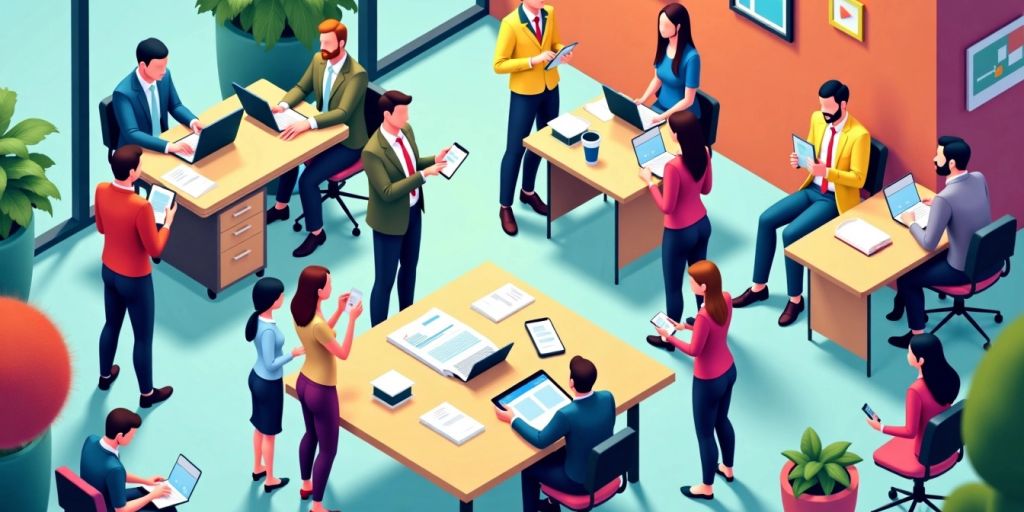In today’s competitive market, delivering an outstanding customer experience is more important than ever. Businesses that focus on optimizing how customers interact with them can see significant improvements in loyalty and sales. This article explores various strategies and technologies that can help enhance customer experiences, ensuring that customers feel valued and supported at every touchpoint.
Table of Contents
ToggleKey Takeaways
- Optimizing customer experience leads to better business outcomes like increased sales and customer loyalty.
- Understanding the difference between customer experience and customer service is crucial for effective strategies.
- Gathering customer feedback is essential to identify areas for improvement.
- Leveraging technology, such as CRM systems and AI, can enhance the customer experience.
- Creating a seamless experience across multiple channels is key to meeting customer expectations.
Understanding the Importance of an Optimized Customer Experience
Defining Customer Experience
Customer experience (CX) is how customers feel when they interact with your business. It includes every touchpoint, from the first time they hear about you to their ongoing relationship with your brand. A great customer experience can lead to loyal customers.
The Impact on Business Outcomes
Optimizing customer experience can significantly affect your business. Companies that focus on CX often see:
- Increased customer loyalty
- Higher sales
- Positive word-of-mouth recommendations
| Business Outcome | Impact of Optimized CX |
|---|---|
| Customer Loyalty | Increases by 20-30% |
| Sales Growth | Up to 15% more |
| Positive Reviews | 50% more likely |
Customer Experience vs. Customer Service
While customer service is a part of customer experience, they are not the same. Customer service focuses on specific interactions, like answering questions or solving problems. In contrast, customer experience is about the overall impression customers have of your business.
Understanding the difference between customer experience and customer service is crucial for improving how customers view your brand.
In today’s fast-paced world, businesses must prioritize consistency and personalization in their interactions. This ensures that customers feel valued and understood, leading to better satisfaction and loyalty.
By focusing on optimizing customer experience, businesses can create a strong foundation for long-term success.
Strategies for Optimizing Customer Experience

Collecting Customer Feedback
Gathering feedback is essential for understanding how customers feel about your business. Ask customers directly through surveys and feedback forms. You can also listen to what they say online. This helps you know what they like and what needs improvement. Here are some ways to collect feedback:
- Surveys after purchases
- Online reviews
- Social media comments
Creating a Customer Journey Map
A customer journey map helps you see how customers interact with your business from start to finish. It breaks down their experience into stages:
- Awareness: When they first hear about you.
- Interest: What keeps them engaged.
- Purchase: The moment they buy.
- Experience: How they feel using your product.
- Loyalty: What makes them come back.
This map helps you find areas to improve and make the experience better for your customers.
Implementing High-Impact Improvements
Once you know what needs fixing, focus on changes that will make the biggest difference. Target high-impact improvements to ensure you get the best return on your investment. This could mean:
- Training staff to be more helpful.
- Upgrading technology for faster service.
- Personalizing customer interactions.
By optimizing customer experience, you can create loyal customers who will recommend your business to others.
In summary, enhancing customer experience involves listening to feedback, understanding the customer journey, and making impactful changes. This approach not only improves satisfaction but also drives business success.
Leveraging Technology for Enhanced Customer Experience

Role of CRM Systems
Customer Relationship Management (CRM) systems are essential tools for businesses aiming to improve their customer experience. They help in organizing customer data, tracking interactions, and managing relationships effectively. Using a CRM can lead to better customer insights and more personalized service.
AI and Automation
Artificial Intelligence (AI) and automation are game-changers in enhancing customer experiences. For instance, chatbots can assist customers 24/7, providing instant responses to inquiries. This not only saves time but also improves customer satisfaction. Here are some benefits of using AI in customer service:
- Faster response times
- Personalized interactions
- Reduced workload for human agents
User Testing and Session Recording
Understanding how customers interact with your website or app is crucial. User testing and session recording allow businesses to see where customers face challenges. This information can help in making necessary adjustments to improve the overall experience.
By leveraging technology, businesses can create a more engaging and efficient customer experience, leading to higher satisfaction and loyalty.
In summary, integrating technology like CRM systems, AI, and user testing can significantly enhance the customer experience, making it more personalized and efficient.
| Technology Type | Benefits |
|---|---|
| CRM Systems | Better insights, organized data |
| AI | Instant responses, personalized service |
| User Testing | Identify pain points, improve usability |
Creating a Seamless Omnichannel Experience
Importance of Consistency
Your customers expect a smooth experience across different channels. About 73% of shoppers prefer using multiple channels for their shopping needs. This means you must ensure that customers can connect with your business consistently, whether they are using a website, mobile app, or social media.
Synchronizing Communication Channels
To create a seamless experience, it’s essential to implement strategies that allow for smooth transitions between platforms. Here are some key strategies:
- Unified customer database: Keep all customer information in one place.
- Integrated customer service: Ensure that support is available across all channels.
- Synchronized communication: Make sure messages are consistent, no matter where customers interact with your brand.
Integrating Customer Service
Focusing on the entire customer journey is crucial. Research shows that customer journeys are more closely linked to business outcomes than individual touchpoints. By understanding the full experience, you can identify areas for improvement.
A well-optimized customer journey can lead to 30% to 40% higher customer satisfaction compared to focusing only on touchpoints.
In summary, creating a seamless omnichannel experience is vital for meeting customer expectations and improving overall satisfaction. As the retail apocalypse continues to reshape the market, businesses must adapt to these changes to thrive.
Future Trends in Customer Experience Optimization
As customer needs and market conditions evolve, businesses must adapt to stay relevant. Here are some key trends to watch for:
Personalization
Customers now expect a tailored experience. With the rise of data collection, businesses can create personalized interactions that resonate with individual preferences. This can lead to increased loyalty and satisfaction.
Immersive Technologies
Emerging technologies like virtual reality (VR) and augmented reality (AR) are transforming how customers engage with brands. These tools can create more engaging and memorable shopping experiences, making it easier for customers to connect with products.
AI and Automation
The use of artificial intelligence (AI) is growing in customer service. Automating repetitive tasks allows businesses to respond faster and more efficiently. This not only improves customer satisfaction but also frees up staff to focus on more complex issues.
The future of customer experience is about being proactive and innovative. Businesses that embrace these trends will likely see better engagement and loyalty.
In summary, staying ahead in customer experience means embracing these trends:
- Personalization: Tailor experiences to individual needs.
- Immersive Technologies: Use VR and AR for engaging interactions.
- AI and Automation: Streamline processes for efficiency.
By focusing on these areas, businesses can enhance their customer experience and drive growth.
Empowering Your Team to Deliver Exceptional Customer Experience
Training and Development
To provide an outstanding customer experience, it’s essential to invest in training your team. This means giving them the skills and knowledge they need to handle customer interactions effectively. Regular workshops and training sessions can help staff understand customer needs better and improve their service skills.
Empathy in Customer Interactions
Empathy is key in customer service. When things go wrong, showing understanding can make a big difference. Customers want to feel heard and valued. By training your team to connect emotionally with customers, you can create a more positive experience.
Empowering Customer-Facing Teams
Give your team the tools they need to succeed. This includes access to information and the authority to make decisions. When employees feel empowered, they can resolve issues quickly without always needing to escalate them. This leads to a more efficient service and happier customers.
A customer experience that emphasizes empathy, empowerment, and engagement will set your business apart from the competition.
Summary
In summary, empowering your team is crucial for delivering an exceptional customer experience. By focusing on training, empathy, and giving your staff the right tools, you can create a customer-centric culture that leads to long-term success. Remember, happy employees lead to happy customers!
Measuring the Success of Your Customer Experience Optimization Efforts
Key Performance Indicators
To truly understand how well your customer experience (CX) optimization is working, you need to track specific metrics. Here are some important key performance indicators (KPIs) to consider:
- Customer Satisfaction Score (CSAT): Measures how satisfied customers are with your service.
- Net Promoter Score (NPS): Gauges customer loyalty and their likelihood to recommend your business.
- Customer Retention Rate: Indicates how many customers continue to do business with you over time.
| KPI | Description | Importance |
|---|---|---|
| Customer Satisfaction | Measures satisfaction with service | High |
| Net Promoter Score | Indicates loyalty and likelihood to recommend | Very High |
| Customer Retention Rate | Shows how many customers stay with you | Critical |
Customer Satisfaction Surveys
Conducting regular customer satisfaction surveys is a great way to gather feedback. These surveys can help you understand what customers like and what needs improvement. Here are some tips for effective surveys:
- Keep questions clear and concise.
- Use a mix of multiple-choice and open-ended questions.
- Analyze the results to identify trends and areas for improvement.
Continuous Improvement
Improving customer experience is an ongoing process. Regularly review your KPIs and survey results to make necessary adjustments. Here are steps to ensure continuous improvement:
- Collect Feedback: Regularly ask customers for their opinions.
- Analyze Data: Look for patterns in the feedback.
- Implement Changes: Make adjustments based on what you learn.
- Monitor Results: Check if the changes have a positive impact.
Remember, a successful customer experience strategy is not just about making changes; it’s about making the right changes based on customer feedback and data analysis.
By focusing on these areas, you can effectively measure and enhance your customer experience optimization efforts, leading to better business outcomes and happier customers.
To truly know if your efforts to improve customer experience are working, you need to measure your success. Look at how happy your customers are and how many new leads you’re getting. Want to see real results? Visit our website for a free demo and start optimizing your customer experience today!






